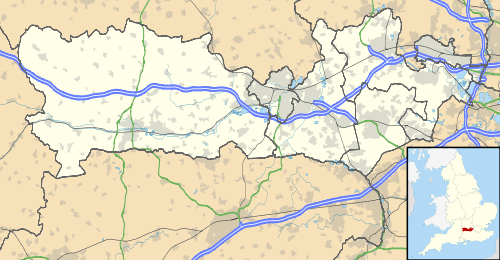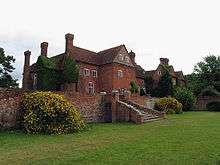Ufton Court
Ufton Court is an Elizabethan manor house at Ufton Nervet in the English county of Berkshire. Today it is an active home to an educational charity, the Ufton Court Educational Trust. As well as historical and environmental education, the site hosts creative projects including theatre and music courses. It is also a wedding and corporate events venue.
| Ufton Court | |
|---|---|
.jpg) View of the house from the main drive | |
 Location within Berkshire | |
| General information | |
| Architectural style | Elizabethan mansion |
| Location | Ufton Nervet |
| Town or city | Berkshire |
| Country | United Kingdom |
| Coordinates | 51.3962°N 1.1016°W |
| Construction started | 1474 |
| Completed | 1474 / 1576 & 1616 (modifications) |

Architecture
Parts of the house date from 1474, including the basis of the great hall and the screens passage complete with the original 'pantry and buttery' doors, although, at Ufton, there was a proper kitchen beyond. From 1568, the place was modified and extended by Elizabeth, Lady Marvyn, a prominent Roman Catholic, including the installation of a magnificent pendant ceiling in the great hall. Two carved beams which she had installed in the Green Room are thought to be older and may have been brought from her former residence nearby. The house is notable for its priest holes where Recusant Catholics could hide priests, their vestments and plate used in the mass. An east wing and Catholic devotional panelling were added in 1616. Further embellishments, including updated panelling, were added in the early 18th century.
History
Late medieval times
The house was originally a small medieval manor called Ufton Pole and was one of the minor manors belonging to Lord Lovell. He was made a Viscount by Edward IV and later became part of Richard III's inner circle. With the death of King Richard in 1485, Lovell rebelled against the new king, Henry VII and had all his lands, including Ufton Pole, confiscated by the Crown.
Tudor and Stuart times
In 1510, Henry VIII granted Pole Manor to Sir Richard Weston, a Groom of the Chamber.
In 1568, the house was bought by Lady Marvyn, the widow of Richard Perkins of Ufton Robert Manor at Ufton Green. She considerably altered and enlarged the house over the next eight years and renamed it 'Ufton Court'. She eventually left the house to her first husband's nephew, Francis Perkins. It remained in this family until 1769.
The Perkins were persecuted for their Catholic beliefs. They had to pay fines for not attending Church of England services at the parish church and could be subjected to raids at any time by local magistrates[1] looking for priests, hidden in tiny secret rooms. In 1599, during the second raid on Ufton, Sir Francis Knollys discovered at least one priest hole containing much gold plate, but the priests were not in residence.[2]
Georgian times
In 1715, Francis Perkins of Ufton Court married Arabella Fermor, the daughter of Henry Fermor of Tusmore in Oxfordshire.[3] Before the marriage, painters and poets celebrated her charms and her beauty, for she was the belle of London society. She is remembered today as the inspiration for Alexander Pope's 'The Rape of the Lock,' a poem telling how Lord Petre stole a lock of her hair and caused a great scandal. Arabella was humiliated and accepted Perkins' offer of marriage in order to live quietly in the country instead. Tradition asserts that the great hall and western half of Ufton Court were refashioned for the lady's arrival, and this seems to fit with the date of the architecture and interior décor there. Bonnie Prince Charlie is supposed to have secretly visited the couple during the Jacobite rising of 1745. They had six children together, but they all died childless and the house gradually fell into a state of disrepair.
Victorian times
'_(11217516175).jpg)
During its sale in 1837, Ufton Court was described as 'unfit for a gentleman's residence.' It was bought by Richard Benyon De Beauvoir of the adjoining estate at Englefield. He repaired the house and converted it into tenements for his estate workers.
Over the next hundred years, various tenants lived in the house: mostly notably Mary Sharp, a local historian who wrote a detailed history of the place. Mr (later Sir) Henry Benyon also lived there himself before inheriting Englefield House, restoring the house as a gentleman's residence once more and replanting the garden.
Educational Centre
Although still owned by the Benyons, Ufton Court is now the home of the Ufton Court Educational Trust. This charity provides opportunities for children and young people to explore the historical and environmental world through hands-on experiences. They host both day visits and residential courses. Many of the rooms are now dormitories and children are encouraged to treat the house as their own. Historical courses range from studies of the Iron Age to the Victorian era. The site includes a Tudor garden and small Saxon/Medieval/Tudor farm with pigs, goats and chickens to look after. In the grounds are a 'Celtic Village,' featuring a reconstructed Iron Age roundhouse, a 'Wheel of the Year' fire circle, a Roman/Saxon palisade and Saxon/Viking ship; as well as the 'Ufton Adventure' woodland centre based around residential cabin accommodation.
The Ufton Dole
The Ufton Dole is a distribution of bread and sheets, from a window in the Great Hall of Ufton Court, every Maundy Thursday to the villagers of Ufton Nervet and Padworth. Lady Marvyn left money in her will of 1581 for this annual dole. Tradition has it that this was to thank the villagers for having helped her return home after becoming lost in the local woods. Additionally, a curse is said to have been placed on any lord of the manor who breaks the tradition. The distribution is currently undertaken by Richard Benyon MP.
References
- Nash Ford, David (2001). "In Search of Catholic Priests at Ufton Court". Royal Berkshire History. Wokingham: Nash Ford Publishing. Retrieved 12 March 2010.
- Nash Ford, David (2008). "Sir Francis Knollys Junior (d.1648)". Royal Berkshire History. Wokingham: Nash Ford Publishing. Retrieved 12 March 2010.
- Nash Ford, David (2001). "Arabella Fermor (1696–1737)". Royal Berkshire History. Wokingham: Nash Ford Publishing. Retrieved 12 March 2010.